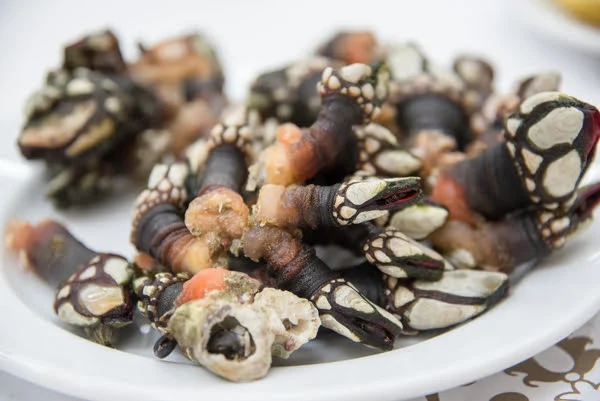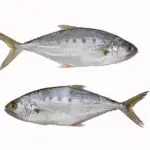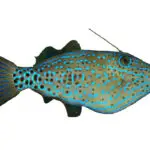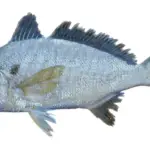If you’ve ever been to the beach or around tidal saltwater areas, then you’ve surely noticed those little shell-like, volcanic-looking creatures clinging desperately to the sides of rocks and boat hulls.
Those little critters are barnacles and while they are a huge nuisance to the boating community, did you know they are also delicious to eat?
Table of Contents
- Are Barnacles Good To Eat?
- What Do Barnacles Taste Like?
- Are Barnacles Safe To Eat?
- Are Barnacles Good For You?
- How To Prepare Barnacles
- How To Cook Barnacles
- How To Eat Barnacles
- Frequently Asked Questions
- Final Thoughts
- Related Posts
Are Barnacles Good To Eat?
Barnacles, although similar in appearance to mussels and snails, are crustaceans and are more closely related to crabs and lobsters. They can be difficult to clean and prepare for cooking, but the flavor is said to be very good.

Barnacles are a mouthwatering delicacy in places like Spain and Portugal. While they are just beginning to appear on menus in the U.S., you should still give them a try!
They grow in intertidal zones in the ocean and can be found clinging to rocks that are repeatedly hit by the tide. Barnacles are available year-round which makes them a great sustainable resource.
Unfortunately, they are very difficult to harvest which drives up the price and limits their availability.
Although there are several varieties of barnacles, the only ones safe for human consumption are gooseneck or percebes, and rock or picoroco, barnacles.
What Do Barnacles Taste Like?
There is some debate about what barnacles taste like. It seems to depend on your tastebuds.
Some people insist they taste like little bits of lobster, while others claim they taste like crab meat. Still, some people seem to only be able to taste salt water.
When prepared correctly, barnacles have a naturally sweet taste – similar to that of lobster meat. The flavor is very light and has a texture like an octopus when cooked well. Barnacles are known to be very delicate food, so be careful not to overcook them.
Gooseneck barnacles have the most meat of the two edible varieties and have a taste that is more of a blend of clam and lobster.
Rock barnacles have less meat and taste more like a cross between scallops and crabs.
If you enjoy shellfish, then you will most likely enjoy barnacles if you can get over their somewhat unsightly appearance.
Are Barnacles Safe To Eat?
Barnacles are safe to eat, but as previously mentioned, rock and gooseneck barnacles are the only two types that should be eaten by humans.
It is also important to know where your barnacles came from as some in the Pacific have been known to feed on microplastic debris in the ocean, not realizing what they were eating.
You don’t want to ingest any microplastic, so be sure to know the origins of your crustaceans before indulging.
Related: Can You Eat Fish Scales? (Would You Even Want To?)
Are Barnacles Good For You?
There are some health benefits of eating rock and gooseneck barnacles, although they are so small you would have to eat a sizable amount to benefit from them.
Regardless, barnacles are rich in iodine, Vitamin B12, fatty acids, calcium, other minerals, and iron. They are believed to be very good for the health of hair, skin, and nails.
Some of the nutrients found in barnacles can also contribute to boosting your body’s metabolism and immune health.
How To Prepare Barnacles
If you want to harvest your own barnacles, then simply pinch them off rocks with your fingers. Once you have them in your hands, squeeze them gently until the meat comes out of the shell.
If you can’t cook them right away, then be sure to leave them in their shells and transport them while they are alive as they spoil very quickly. It should be noted that despite living in a marine environment, barnacles should not be stored in water, but rather in a somewhat dry container.
Store them in your refrigerator until ready to cook, but with most delicate seafood they are best if eaten fresh (same day!).
How To Cook Barnacles
Barnacles are one of the easiest foods to prepare, but they also have detrimental outcomes if you slip up.
While barnacles can be steamed, they are best prepared by boiling them in salt water. The water should be the same salinity as the ocean and be brought to a rolling boil.
Once the water is boiling, drop the barnacles in and cook for exactly 10 minutes, stirring occasionally. After 10 minutes, place the barnacles immediately into an ice bath to stop the cooking process.
If the barnacles cook for more than 10 minutes, their consistency will change to a rubbery texture and their delicate, light flavor will be lost.
Barnacles are best paired with very light sauces like garlic or lemon butter. Many people simply lightly salt them and squeeze a lemon over the top before indulging.
How To Eat Barnacles
While delicate and delicious, barnacles are a strange thing to eat…which explains why they’re not common on western restaurant menus.
Gooseneck barnacles will still have the shell or foot attached and will have a tubular casing around the neck or body.
To eat them, hold the shell between your fingers, then twist and pull the meat out of the tube of the neck or body. Once the meat is out of the tube, it will be a bright coral color – this is the part you eat. Barnacles are small, so each one will be consumed in 1-2 small bites.
Barnacles are really a delicacy style food, not something you eat an entire meal of. They are great when paired with wine, garlic bread and good company.
Frequently Asked Questions
Can You Eat Barnacles Raw?
Yes, you can eat barnacles raw, but it is not commonly done and not recommended. Given the texture, they will most likely be very unpleasant if eaten raw. Boiling them as described above would be a much better option.
Do Barnacles Have Worms?
No, barnacles don’t have worms. However, barnacles themselves can be parasites. One type, in particular, the rhizocephalan barnacle, infects crabs and other crustaceans turning them into “zombie crabs”.
Can Barnacles Grow On Humans?
Yes. It’s very rare, but if the sharp edge of a barnacle pierces your skin there is a possibility that the wound can become infected and in extremely rare instances, barnacles have begun to grow in human flesh.
While excruciatingly painful, this can be treated with a long-term course of antibiotics and possible surgeries. It’s better to avoid coming in contact with barnacles in the wild altogether though.
Final Thoughts
Although a nuisance and painful to come in contact with in the wild, barnacles are considered a delicacy in some parts of the world.
If you’re feeling adventurous, boil them in salt water and add a little salt and lemon to bring out their natural sweetness.
Then, enjoy a Spanish and Portuguese delicacy many aren’t daring enough to try.
Thanks for reading!
You May Also Like: Are Stingray Fish Good to Eat? You May Be Surprised!





